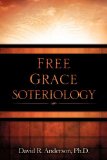Free Grace Soteriology. By David R. Anderson. NP: Xulon Press, 2010. 383 pp. Paper, $20.99.
Designed as a textbook for college and seminary classes, Anderson’s book meets a significant need. Hopefully textbooks for the nine other major doctrines will soon be produced by Anderson and others.
The book has the following chapter titles: the meaning of soteriology, the sinfulness of man, salvation in the OT, the cross of Jesus Christ, justification, the order of salvation, repentance, faith, eternal security, assurance of salvation, regeneration, Lordship Salvation, infants and heathen, and divine sovereignty and human responsibility. Those chapters are highly practical and cover the major issues from a Free Grace perspective.
In the opening chapter Anderson does a nice job of showing what most textbooks on soteriology fail to show, that salvation in the Bible is broader than regeneration. Salvation in the Bible is deliverance of many kinds.
The discussion on salvation in the OT, though helpful, stopped short of being clear on what OT people believed in order to be born again (see pp. 65-66).
In the chapter on the cross, in addition to covering substitution Anderson also discusses the extent of the atonement. He concludes “that Christ’s death is sufficient to pay for the sins of the whole world of mankind, but efficientonly for those who believe” (p. 103, italics his). While this is a typical Free Grace understanding, it would have been helpful to have a brief discussion of the possibility that it is both sufficient and efficient for all and that the issue in regeneration is not sin, which Jesus has taken away (John 1:29; 1 John 2:2), but death and life eternal. Some, including this reviewer, within the Free Grace camp hold that view.
Anderson argues that repentance, understood as “the internal resolve to turn from one’s sins” (p. 139), is not a condition of everlasting life. His discussion on repentance is excellent, though some will be disappointed that he fails to discuss the change of mind view, which is held by some in Free Grace circles.
So, too, the author’s discussion of saving faith in the NT is outstanding (pp. 163-83). Anderson defends the idea that there is no type of faith in Christ as Savior that is not saving. He gives an excellent discussion of John 2:23-25, Jas 2:14-26, and other tough texts on saving faith.
The discussions of eternal security and assurance are excellent, though I was surprised that Anderson did not use some obvious texts where the Lord taught eternal security and assurance (e.g., John 3:16; 5:24; 6:35, 37, 39; 11:26).
Regarding those who haven’t heard, Anderson argues persuasively that “if someone responds to the light they have been given by God, they will receive more light” (p. 272).
There is no discussion of the current controversy over the precise content of saving faith. While I think at least a short discussion of this issue would be helpful in a book on Free Grace soteriology, I certainly understand the author’s reluctance to include such a discussion. If he wishes this work to be used widely by all Free Grace people, then he doesn’t want to risk eliminating many of his potential audience.
Instead of footnotes, this work has endnotes, which are strangely called footnotes on p. 353.
It really would have been helpful if this book contained Scripture and subject indexes. When the second printing occurs, I strongly suggest adding them.
I recommend this work as a helpful textbook on soteriology.
Robert N. Wilkin
Editor
Journal of the Grace Evangelical Society
Denton, Texas


